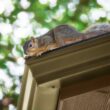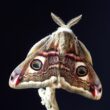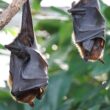South Dakota hosts over 443 documented moth species, ranging from tiny micromoths to giants with six-inch wingspans. While you’re likely familiar with butterflies, moths in South Dakota actually outnumber their daytime cousins by a significant margin and play crucial roles in pollination and the food chain.
Whether you’re checking your porch light after sunset or exploring forests and prairies, you’ll discover an incredible diversity of these often-overlooked insects right in your backyard.
This guide covers 25 distinctive moths you can actually spot across the state, from the massive eyespots of Polyphemus moths to the hummingbird-like flight of sphinx moths.
You’ll learn what makes each species unique, where to find them, and how to identify them during your next outdoor adventure.
Polyphemus Moth
The Polyphemus moth (Antheraea polyphemus) ranks among the most recognizable moths in South Dakota thanks to its enormous eyespots that resemble the face of a great horned owl. These striking patterns serve as a defense mechanism, startling and confusing potential predators.
You’ll find these beauties in forests, orchards, wetlands, and urban areas throughout the state. Adults have a remarkably short lifespan of only four days, during which they focus entirely on reproduction.
Males use their large, feathery antennae to detect pheromones released by females from distances up to seven miles away. The moths don’t eat during their adult stage since they lack functional mouthparts.
Key Features:
- Wingspan of 4-6 inches makes them one of South Dakota’s largest moths
- Large eyespots on hindwings with yellow, black, and blue coloring
- Tan to reddish-brown overall coloration
- Active from late spring through summer
Cecropia Moth
The Cecropia moth (Hyalophora cecropia) claims the title as South Dakota’s largest native moth species, with wingspans reaching six inches. These magnificent insects display a complex pattern of red, white, and black bands across their wings, with distinctive crescent-shaped white spots near the center.
Like their Polyphemus relatives, adult Cecropia moths live only about two weeks and don’t feed. They emerge from their cocoons with one purpose: finding a mate. You’re most likely to spot them near outdoor lights during May and June, particularly in wooded areas where their caterpillars feed on maple, cherry, and birch trees.
Pro Tip: Look for Cecropia moths around porch lights on warm spring evenings. Their large size and bold patterns make them impossible to miss.
Luna Moth
Luna moths (Actias luna) are among the most ethereal insects you’ll encounter in South Dakota. Their pale green wings seem to glow in moonlight, and their distinctive long tails trailing from the hindwings make them unmistakable. These delicate-looking moths are actually quite robust, adapted to fly during cool spring nights.
The tail extensions serve a practical purpose beyond beauty—they create erratic flight patterns that help the moths evade bat predation by interfering with echolocation. Adults live for approximately one week, during which they rely entirely on energy stored from their caterpillar stage. You’ll find them in deciduous forests and areas with white birch, hickory, and walnut trees.
Where to Find Them:
- Hardwood forests throughout South Dakota
- Suburban areas with mature trees
- Active from April through July
- Most visible during the first few hours after sunset
Io Moth
The Io moth (Automeris io) presents one of nature’s most dramatic reveals. When at rest with wings folded, males appear bright yellow while females show reddish-brown coloring. However, when threatened, they flash open their wings to display enormous eyespots on the hindwings that startle predators.
You should exercise caution around Io moth caterpillars, which are covered in venomous spines that can cause painful stings. The adult moths are harmless and fascinating to observe. Males are active fliers during daylight hours, while females fly at night. Look for them in forests, fields, and gardens from May through August.
White-Lined Sphinx Moth
The white-lined sphinx moth (Hyles lineata) often gets mistaken for a hummingbird due to its rapid wing beats and hovering flight pattern. This impressive moth feeds on flower nectar while in flight, using its long proboscis to reach deep into blossoms.
These moths are powerful fliers capable of migrating long distances. In South Dakota, you’ll find them in gardens, meadows, and anywhere flowering plants grow abundantly. They’re active during both dawn and dusk, making them easier to observe than strictly nocturnal species. The distinctive white lines running across their brown forewings and pink hindwings make identification straightforward.
Identification Features:
- Tan to brown forewings with distinctive white stripes
- Pink hindwings with black borders
- Wingspan of 2.5-3.5 inches
- Hovers while feeding on nectar
Tersa Sphinx Moth
The Tersa sphinx moth (Xylophanes tersa) sports a sleek, aerodynamic appearance with its streamlined body and swept-back wing shape. These moths have brown and tan camouflage patterns that help them blend into bark during daytime rest.
You’ll most commonly encounter them in southern and eastern South Dakota, where they visit tubular flowers like petunias and honeysuckle during twilight hours. Their flight is swift and direct, and they’re particularly attracted to white or pale-colored flowers. The wingspan ranges from 2.6 to 3.5 inches, and their olive-brown coloration features distinctive dark and light bands.
Hummingbird Clearwing Moth
Despite its name, the hummingbird clearwing moth (Hemaris thysbe) is definitely a moth, not a bird. This remarkable insect flies during daylight hours and produces an audible hum with its rapidly beating wings. The transparent sections of its wings—free of the scales that typically cover moth wings—give it a distinctly bee-like appearance.
You can observe these moths visiting gardens throughout South Dakota from May through August. They show a preference for red, orange, and purple flowers, hovering expertly while feeding. Their reddish-brown body, olive-colored back, and burgundy tail tuft make them easily identifiable once you know what to look for.
Common Mistake: Many people report seeing hummingbirds when they’ve actually spotted hummingbird clearwing moths. The key differences are the antennae and the visible wings during flight.
Vine Sphinx Moth
The vine sphinx moth (Eumorpha vitis) displays beautiful muted colors of pink, brown, and tan across its wings. These medium-sized sphinx moths have a wingspan of about 2.5-3 inches and show variable patterns that sometimes include olive-green tones.
You’ll find them in areas where their host plants—primarily grape vines and Virginia creeper—grow abundantly. Adults are active from June through September and feed on the nectar of various flowers during twilight hours. Their caterpillars are impressive creatures that can reach four inches in length, with prominent eyespots that help deter predators.
Western Poplar Sphinx Moth
The western poplar sphinx moth (Pachysphinx occidentalis) is a robust gray moth that you might spot around poplar and willow trees throughout South Dakota. These large moths have wingspans reaching 3-4 inches and display subtle but attractive patterns of gray, brown, and white.
Active from May through July, these moths rest on tree bark during the day, where their camouflage makes them nearly invisible. At night, they come to lights and feed on flower nectar. Their caterpillars feed on cottonwood, aspen, and willow leaves, making them common in riparian areas and anywhere these trees grow.
Achemon Sphinx Moth
The Achemon sphinx moth (Eumorpha achemon) stands out with its pink and brown coloration and distinctive wing shape. The forewings are triangular with scalloped outer edges, while the hindwings show vibrant pink bands that contrast beautifully with the brown base color.
These moths are particularly attracted to gardens with grape vines, their primary caterpillar host plant. Adults emerge from June through August and feed on deep-throated flowers like petunias, honeysuckle, and bouncing bet. With a wingspan of 3-4 inches, they’re substantial enough to notice when they visit your garden at dusk.
Key Insight: Achemon sphinx moths undergo a complete color transformation from caterpillar to adult. The caterpillars can be green or brown with distinctive white spots and false eyespots.
Blinded Sphinx Moth
The blinded sphinx moth (Paonias excaecata) gets its unusual name from the small blue eyespots on its hindwings that appear “blinded” by the surrounding pink coloration. These medium-sized moths have wingspans of 2-3 inches and display muted tones of gray and brown on their forewings.
You can find them in wooded areas throughout South Dakota from May through August. They prefer habitats with their host plants, which include willow, poplar, birch, and cherry trees. Adults are attracted to lights and flowers, though they’re less commonly observed than some other sphinx moth species. The subtle beauty of their patterning becomes apparent when you examine them closely.
Fig Sphinx Moth
The fig sphinx moth (Pachylioides resumens) is a less common visitor to South Dakota, typically appearing in the southern portions of the state. These moths have warm brown coloring with subtle lighter patterns across their wings and a wingspan of approximately 3-3.5 inches.
Despite their name suggesting a preference for fig trees, these moths actually use various plants as caterpillar hosts, including grape vines and evening primrose. Adults fly from June through September and are most active during the hours just after sunset. Their mottled brown appearance provides excellent camouflage against tree bark during daylight hours.
Pandora Sphinx Moth
The Pandora sphinx moth (Eumorpha pandorus) is one of the more attractive sphinx moths you’ll encounter in South Dakota gardens. These large moths sport a beautiful combination of olive-green and pink coloring, with the pink especially prominent on the hindwings and along the body.
With wingspans reaching 3.5-4.5 inches, Pandora sphinx moths are substantial insects that make an impression when they visit your garden at twilight. They’re particularly fond of feeding on petunia, bouncing bet, and phlox nectar. You’ll find them from June through September, especially in areas where grape vines and Virginia creeper grow, as these serve as the primary food sources for their large green caterpillars.
Carolina Sphinx Moth
The Carolina sphinx moth (Manduca sexta), also known as the tobacco hornworm moth, is a powerful flier with a robust gray body and intricate wing patterns. These large moths have wingspans of 4-5 inches and six distinctive pairs of orange-yellow spots along their abdomen, which inspired their scientific name sexta (meaning six).
You might consider these moths agricultural pests since their caterpillars—tobacco hornworms—feed voraciously on tomato, tobacco, and other nightshade family plants. However, the adult moths are impressive pollinators with a preference for deep-throated flowers like moonflower, jimsonweed, and sacred datura. They’re strong, fast fliers active from dusk through the night during June through September.
Tomato Hornworm Moth
The tomato hornworm moth (Manduca quinquemaculata) closely resembles its relative, the Carolina sphinx moth, but has five pairs of yellow spots on the abdomen instead of six. These moths are just as robust, with wingspans of 4-5 inches and the same powerful hovering flight.
Gardeners often encounter these moths indirectly through their caterpillar form—the dreaded tomato hornworm that can defoliate tomato plants overnight. Despite this reputation, adult moths serve as important pollinators for native plants and are fascinating to observe. They visit tubular flowers during twilight and nighttime hours, using their long proboscis to access nectar from deep within blossoms.
Important Note: Both tomato and tobacco hornworm moths look very similar as adults. The most reliable way to distinguish them is by counting the abdominal spots, though you’ll need a close view to do so.
Giant Leopard Moth
The giant leopard moth (Hypercompe scribonia) is a stunning species that looks like nature decided to paint spots on a white canvas. These striking moths have pure white wings covered in dark blue-black spots, creating a pattern reminiscent of a leopard’s coat.
You’ll find these beautiful moths throughout South Dakota from May through August. They’re attracted to lights and are most active at night. The wingspan ranges from 2.5-3.5 inches, and their furry white body is marked with metallic blue rings. Their caterpillars—known as woolly bears—are black with red bands and covered in stiff bristles. Unlike many moths, adults may occasionally feed on flower nectar, though this behavior is uncommon.
Virgin Tiger Moth
The virgin tiger moth (Grammia virgo), also called the Anna tiger moth, displays an eye-catching pattern of black and white on its forewings combined with red-orange hindwings. These medium-sized moths have wingspans of about 1.5-2.5 inches and belong to the tiger moth family, known for their bold warning coloration.
The distinctive patterns aren’t just for show—they advertise the moth’s chemical defenses. Tiger moths accumulate toxic compounds from the plants their caterpillars eat, making them unpalatable to predators. You can spot them in meadows, prairies, and gardens from May through August. They’re attracted to lights at night and rest with their wings spread flat during the day, fully displaying their striking coloration.
Banded Tussock Moth
The banded tussock moth (Halysidota tessellaris) presents an identification challenge even for experts. These moths are nearly identical to sycamore tussock moths, and only DNA analysis or dissection can definitively distinguish between them. Adults have pale yellow to cream-colored wings with delicate checkered patterns and wingspans of 1-1.75 inches.
You’ll find them in deciduous forests throughout South Dakota from May through August. Their caterpillars are more distinctive than the adults, sporting long tufts of hair in various colors including white, black, and yellow. Adult moths visit flowers for nectar and are occasionally spotted around outdoor lights near forested areas.
Yellow Underwing Moth
Yellow underwing moths belong to several species in the Noctua genus, and they’re named for their distinctive bright yellow hindwings that flash when the moth takes flight. At rest, only their drab brown forewings are visible, providing excellent camouflage against soil and bark.
These medium-sized moths have wingspans of 1.5-2 inches and are common in gardens, fields, and disturbed areas throughout South Dakota. Adults fly from July through October and feed on flower nectar, fermenting fruit, and tree sap. When threatened, they flash their yellow underwings to startle predators before quickly hiding them again. Their caterpillars, called cutworms, feed on various low-growing plants.
Cabbage Looper Moth
The cabbage looper moth (Trichoplusia ni) is a small, mottled brown moth with distinctive silver-white markings on its forewings that resemble a figure eight or sideways infinity symbol. These moths have wingspans of 1-1.5 inches and can be found throughout South Dakota’s growing season.
Gardeners know these moths well because their caterpillars—cabbage loopers—are significant pests of cruciferous vegetables like cabbage, broccoli, and kale. The caterpillars get their name from their distinctive looping movement, arching their bodies as they crawl. Adults are attracted to lights and can be observed flying at dusk and throughout the night from spring through fall.
Fall Armyworm Moth
The fall armyworm moth (Spodoptera frugiperda) is a grayish-brown moth with intricate darker markings and a wingspan of about 1.5 inches. While the adults are relatively nondescript, their caterpillar form can cause significant agricultural damage to corn, soybeans, and grasses.
These moths don’t typically survive South Dakota winters and must migrate north from southern states each year. You’ll find them in agricultural areas and grasslands from summer through fall. Adults are most active at night and are strongly attracted to lights. The moths can fly considerable distances—sometimes hundreds of miles—which helps them colonize northern areas each growing season.
Pro Tip: Fall armyworm populations vary significantly from year to year depending on migration patterns and weather conditions. Some years bring large numbers, while other years see few individuals.
Salt Marsh Moth
The salt marsh moth (Estigmene acrea) is a beautiful white or cream-colored moth with small black spots scattered across its wings. These medium-sized moths have wingspans of 1.5-2.5 inches and a fuzzy yellow-orange abdomen marked with black spots.
Despite their name, you don’t need to live near salt marshes to encounter these moths in South Dakota. They inhabit various open habitats including prairies, gardens, and agricultural fields. Adults fly from June through September and are attracted to lights. Their caterpillars, called woolly bears or salt marsh caterpillars, feed on a wide variety of low-growing plants and are covered in long, bristly hairs.
Painted Tiger Moth
The painted tiger moth (Arachnis picta) showcases bold patterns of black, white, and orange that serve as warning coloration. These small to medium moths have wingspans of 1.25-1.75 inches and belong to the tiger moth family, which is known for species that accumulate toxic compounds for defense.
You can find painted tiger moths in meadows, prairies, and open woodlands throughout South Dakota from May through August. They’re active at night and frequently come to lights. The forewings display a complex pattern of black and white, while the hindwings show more orange coloring. Their caterpillars feed on various herbaceous plants and are covered in dense tufts of hair.
Melonworm Moth
The melonworm moth (Diaphania hyalinata) is a delicate-looking moth with semi-transparent white wings edged in brown or black. These moths have a lustrous, iridescent quality to their wings and a wingspan of about 1-1.25 inches. Their body is slender and white with subtle darker markings.
In South Dakota, these moths appear primarily during the warmer months as they migrate north from southern regions where they overwinter. Their caterpillars feed specifically on cucurbit plants—melons, squash, cucumbers, and pumpkins—making them occasional garden pests. Adults are active during both day and night and visit various flowers for nectar. You’re most likely to spot them in areas where cucurbit crops or wild gourds grow.
Pickleworm Moth
The pickleworm moth (Diaphania nitidalis) closely resembles the melonworm moth but has more extensive brown coloring on the wings and a wider brown band around the wing margins. These small moths have wingspans of approximately 1 inch and share the same iridescent, semi-transparent wing quality as their relatives.
Like melonworm moths, pickleworms are primarily southern species that occasionally reach South Dakota during summer months. Their caterpillars bore into cucurbit fruits, especially cucumbers and squash, which is how they earned their common name.
Adults are attracted to lights and flowers and can be active both during the day and at night. While they’re not as common in South Dakota as in southern states, warming temperatures may increase their presence in future years.
Finding Moths in South Dakota
The best time to observe moths is during warm evenings from late spring through early fall. A simple white sheet hung near a light source—particularly a black light or UV light—can attract dozens of species in a single night.
Check around porch lights, gas station lights, and other outdoor illumination for moths that have been drawn in. Many species also visit flowers during twilight hours, making gardens excellent observation sites.
Remember that moths are far more than just “night butterflies.” They’re crucial pollinators, important food sources for wildlife, and fascinating subjects for observation.
South Dakota’s diverse habitats support hundreds of species, and this guide only scratches the surface of the moth diversity you might encounter throughout the state.








